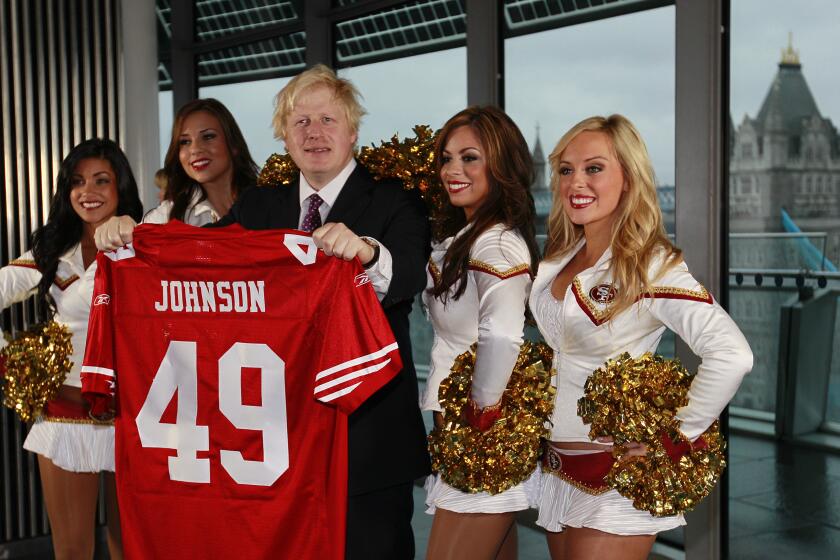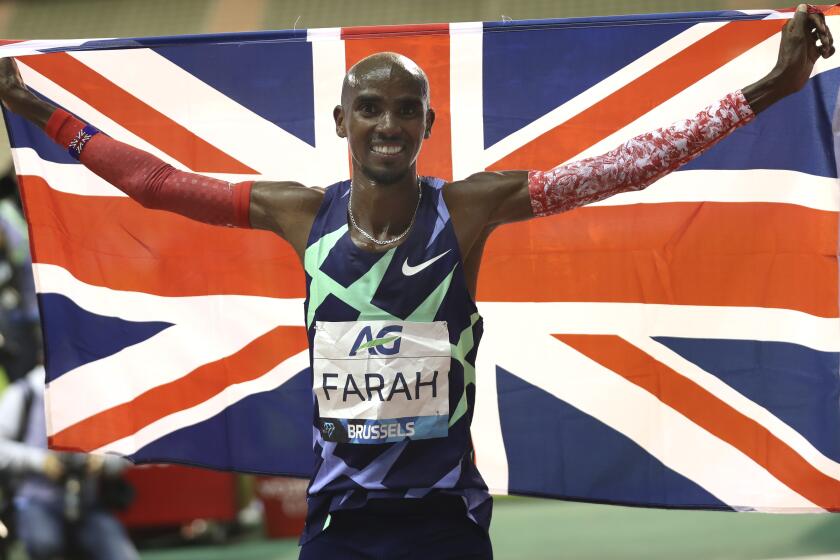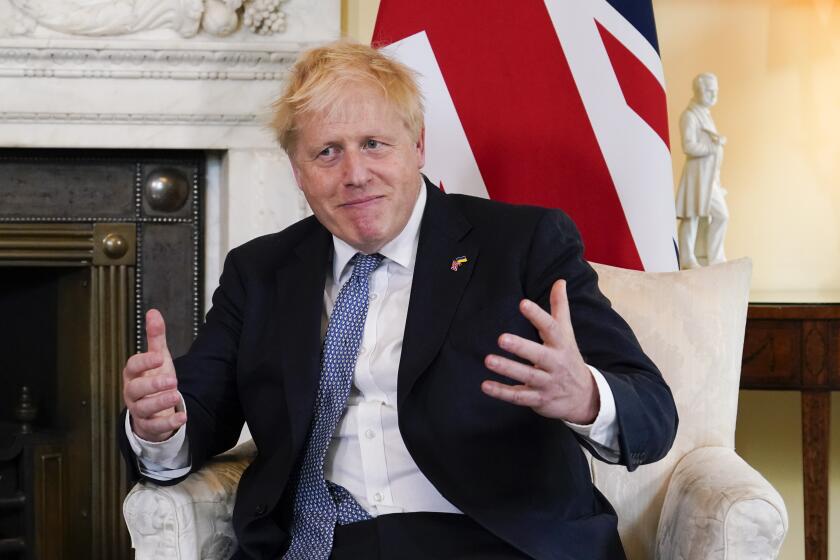Britain’s next prime minister is unlikely to be a white man
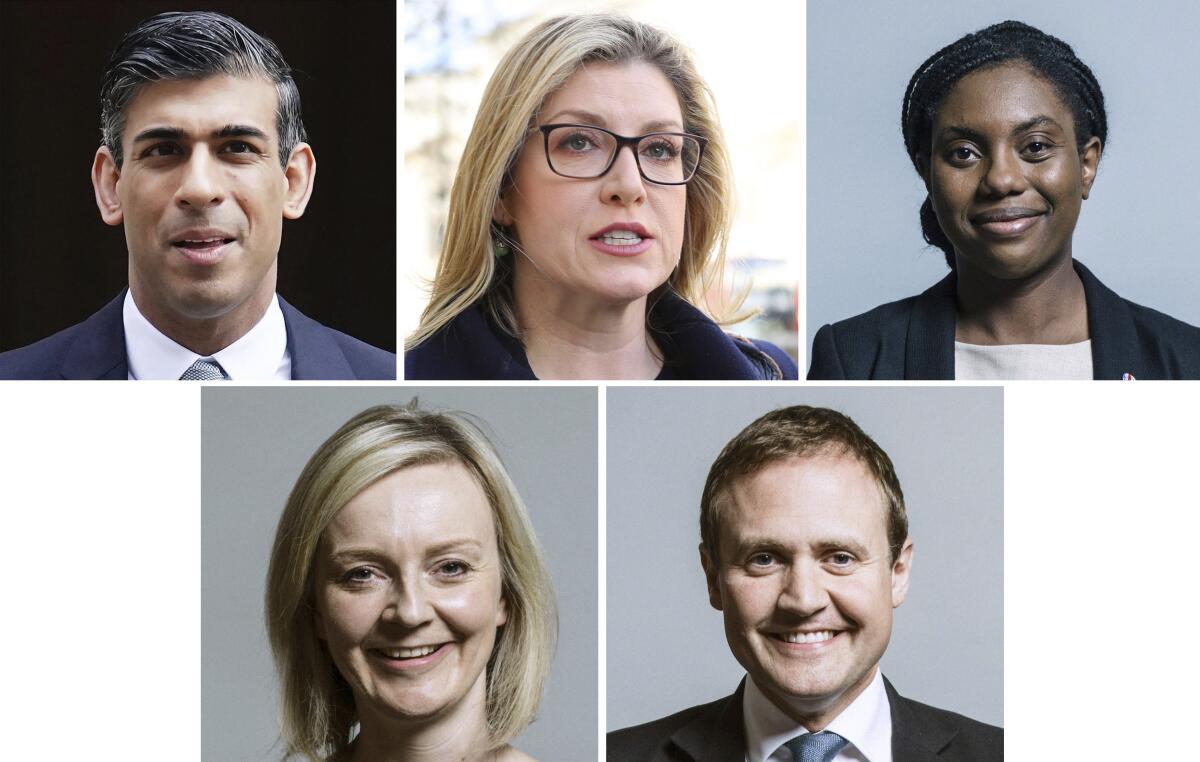
- Share via
LONDON — For the first time in history, Britons could soon have a person of color as their prime minister. Even more, that person could also be a woman.
What it’s least likely to be: a white male.
A historically diverse slate of candidates is vying to succeed Prime Minister Boris Johnson, who announced his resignation this month as premier and as leader of the Conservative Party after a series of ethics scandals. The competition is down to five contenders, only one of whom is a white man — a development that might seem all the more surprising considering that the Conservatives stand exactly where their name implies: firmly on the right.
But unlike in the U.S., where Democrats are better known for their diverse politicians and historic firsts with race and gender — President Obama and Vice President Kamala Harris among them — the race in Britain has cemented the Conservative Party as the one of diversity, at least at its highest levels if not its general membership.
Those still in contention to become party leader, and thus prime minister, comprise three white people (two of them women), one man of Indian descent and one woman of Nigerian descent.
“The Tories are showing Labor how it’s done on diversity,” read a recent headline on the website of the Spectator, a right-wing political magazine, comparing conservative leaders with liberal ones in matters of race in Britain, mirroring similar disagreements in America.
Boris Johnson’s resignation was the latest act in a career full of downfalls, comebacks and scandal. What comes next?
“This is a party that has famously had two female prime ministers,” Nick Pearce, a professor at the University of Bath, said, referring to Margaret Thatcher and, more recently, Theresa May. “But it has not had the same ethnic diversity even as the population has grown more diverse. It is a significant moment on the world stage.”
The candidates are former Treasury chief Rishi Sunak — who has come out on top in both rounds of elimination votes by Tory lawmakers so far — Trade Minister Penny Mordaunt, Foreign Secretary Liz Truss, former Equalities Minister Kemi Badenoch and backbench lawmaker Tom Tugendhat. Tugendhat, the only white male candidate, received the least number of votes of the five surviving contenders in Thursday’s elimination round.
An earlier slate of 11 candidates included even more politicians of color, of Iraqi, Pakistani and Indian heritage.
It’s a striking difference from 2019, when Johnson handily beat nine other contenders — only two of them women and just one a member of an ethnic minority.
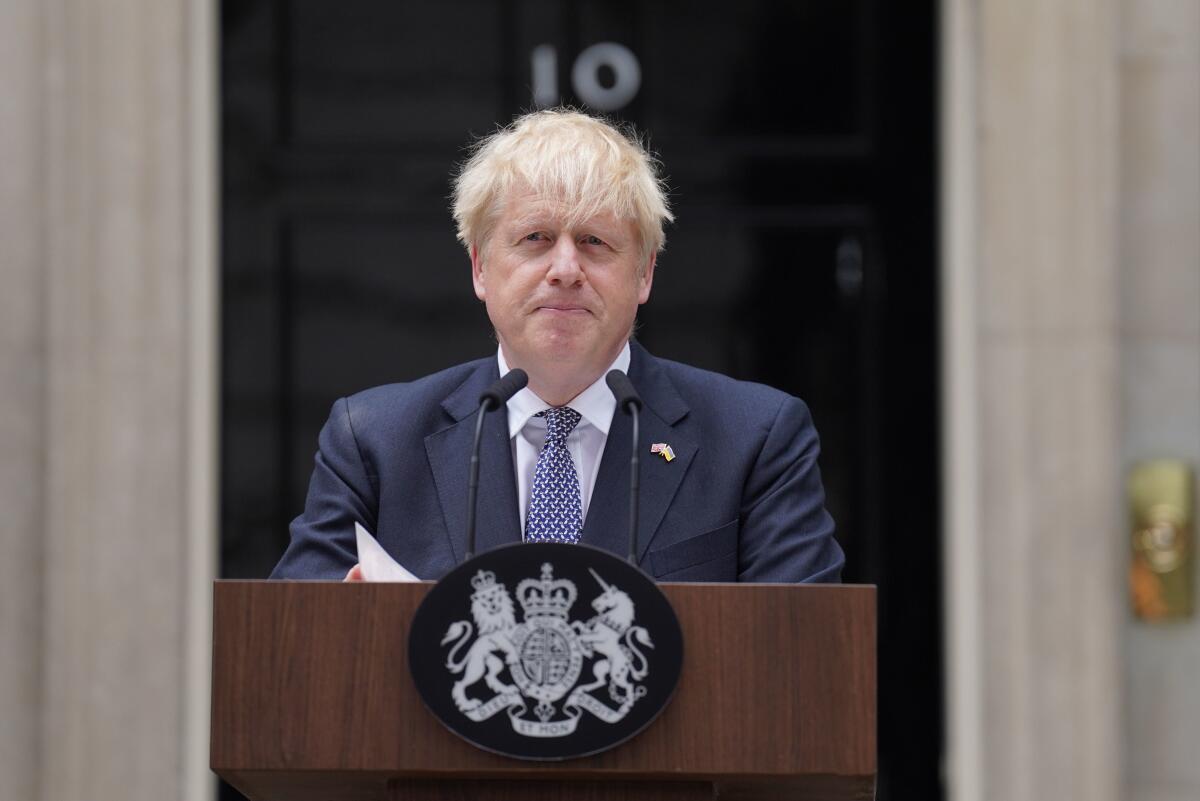
“This is all happening very intentionally,” said Rainbow Murray, a professor of politics at Queen Mary University of London. “The Conservatives have long had an image problem. They looked old-fashioned, stuck in the past, and not known for inclusive values.”
After election defeats in the late 1990s and early 2000s, “they decided they needed to reinvent themselves,” Murray said. “A lot of credit is given to [former Prime Minister] David Cameron for creating an A-list of diverse stars he wanted to see rise. But it started even before then with Theresa May.”
Twenty years ago, May famously gave a speech in which she called her party “the nasty party” because its base was “too narrow,” along with its “sympathies.”
But analysts caution that the diversity among the current crop of prime ministerial hopefuls does not necessarily mean that liberal or progressive policy positions on matters of race and gender will follow.
Boris Johnson was the London mayor who hosted the Olympics, the leader who pledged to ‘get Brexit done’ and the premier brought down by ‘Partygate.’
Several of the candidates are ardent backers of Britain’s exit from the European Union, a withdrawal that was fueled in part by anti-immigrant sentiment. All support a controversial new government policy to deport asylum seekers to Rwanda for processing, a plan condemned as shameful by activists.
Badenoch, who is Black, and Suella Braverman, a recently eliminated candidate of Indian descent, have eagerly derided opponents as “too woke.” Mordaunt has been forced by her rivals to backtrack on her support for transgender people.
“These ministers may be diverse. But they tend to match their white colleagues in class and wealth. They tend to vote the same way,” said Pearce. “They tend to represent areas that are more rural, conservative and have fewer ethnic minorities.”
He also noted that those who will pick the prime minister in the final round — Conservative Party members — largely tend to be older and whiter. After Conservative lawmakers narrow the field to two this week in voting beginning Monday, the party members, who number around 200,000, will cast the deciding votes by mail. The result is expected Sept. 5, when Johnson will leave his post.
Breaking News
Get breaking news, investigations, analysis and more signature journalism from the Los Angeles Times in your inbox.
You may occasionally receive promotional content from the Los Angeles Times.
“If an ethnic minority is chosen, it of course will be a significant moment,” Pearce said. “It will be an important one if a woman is chosen too. But we have already done that twice, so it’s no longer the same barrier.”
The Labor Party has also made strides. Its membership is more diverse overall than the Conservatives, and does significantly better among voters who are people of color. On its website, it boasts of being “proud to have more women and BAME (‘Black, Asian and minority ethnic’) MPs than all of the other political parties put together.”
But the party has never had a female leader, and it was only last year that Anas Sarwar was chosen to head the party in Scotland in what was hailed as the first time a person of color was picked to head a major British political party or one of its branches in Scotland, Wales or Northern Ireland.
Writing in the London Evening Standard, the founder of an organization that focuses on helping disadvantaged minority groups in British society described the moment for Conservatives as one when Britain’s leaders might finally “reflect the country they seek to serve,” at least in race.
Four-time Olympic champion Mo Farah says he was brought into Britain illegally from Djibouti under the name of another child.
“None of the diverse Conservative candidates are running on the platform of being the first ethnic minority prime minister; they are running on their policies and agenda,” wrote Harris Bokhari of the Patchwork Foundation. “They just happen to be from minority backgrounds.”
The British public, he said, looks at leaders based on what they do and believe, not where they or their families came from — although plenty of critics would disagree, at least when it comes to social class, which is still a fraught issue in this country.
Sunder Katwala, director of British Future, a think tank that looks at people’s hopes and fears about immigration, identity and race, described the moment as “striking” for how quickly it has arrived.
The Conservative Party had its first member of Indian descent elected to Parliament in the late 1800s. It took close to a century for it to happen again when Nirj Deva was elected in 1992.
Britain’s scandal-plagued prime minister saw his leadership challenged when enough lawmakers in his party called for a vote of no confidence. He survived — but not without damage.
There were no women of Asian descent in the House of Commons until 2010 and no people of Asian background in the most senior offices until 2018, when Sajid Javid became home secretary.
“The point we’ve got to in Britain is the normality of ethnic diversity at the top,” Katwala said. “You now have normal ethnic diversity in the left party and the right.
“As with women, we’re not now saying: ‘What do the minority candidates think or stand for?’ This is really useful for the normalization of diversity.”
Kaleem is a Times staff writer and Boyle a special correspondent.
More to Read
Sign up for Essential California
The most important California stories and recommendations in your inbox every morning.
You may occasionally receive promotional content from the Los Angeles Times.

